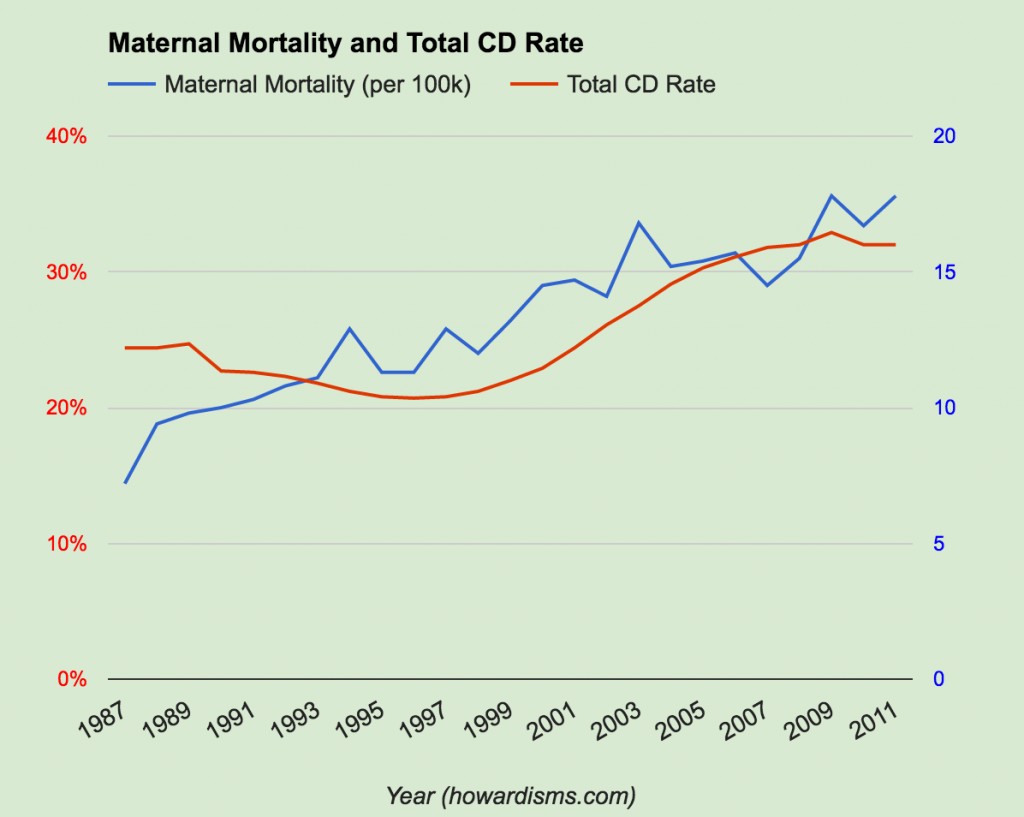The graphic above shows the drop in maternal mortality since about 1840 (blue line) along with the drop in perinatal mortality over the same time (red line).
In the middle of the 19th Century, even in the Western world, a pregnant woman had about a 1% chance of dying during a given pregnancy; since there were no effective means of contraception, the average woman in America had about 11 pregnancies. This gave her a lifetime risk of around 1 in 8 or 1 in 9 of dying due to pregnancy. This rate of maternal mortality is still seen in some parts of sub-Saharan Africa today.
Women died in the past primarily of:
- Infection
- Hemorrhage
- Toxemia (eclampsia, etc.)
- Embolism
Take a look at some of the interventions that changed this:
- The combination of safe anesthesia along with aseptic technique (and eventually antibiotics) led to safe Cesarean delivery which ended many horrors associated with cases of cephalopelvic disproportion and other emergencies that often led to death of both mother and baby.
- Prophylactic and therapeutic use of ergotamine and later oxytocin along with blood transfusion greatly impacted death from hemorrhage.
- The ability to predict the development of eclampsia and safe induction virtually eliminated deaths from “toxemia.” Indeed, our whole system of prenatal care today is centered around the blood pressure cuff.
- Heparin and other anticoagulants finally provided an effective treatment for embolism.
- Pasteurization of milk greatly reduced neonatal death due to contaminated milk.
- Babies were born healthier and more likely alive given the availability of safe Cesarean (rather than septic and/or mutilated).
- Antibiotics for treatment and prophylaxis of infection dramatically helped mothers and babies.
- The move of birth into the hospital largely occurred because that was the place that new miracles like Penicillin, ergotamine, oxytocin, safe Cesarean, and other life-saving interventions were located.
- Babies further benefited from the discovery of anti-D antibody (Rhogam), corticosteroids, and the creation of NICUs centered around high-frequency ventilation.
- Effective birth control limited the exposure of women to pregnancy (and therefore whatever death rate was associated with each). We have gone from about 11 pregnancies to 2.2 per woman.
The Spanish Flu pandemic of 1918 was horrific for mothers and babies and signals the importance of Flu shots (and other vaccines) today.
Unfortunately, you can get too much of a good thing. The over-utilization of Cesarean delivery over the last 30 years has led to an increase in maternal mortality since about 1987 with no attributable benefit to babies, but at an expense of an increase in maternal mortality since that year. Some of the increase is no doubt related to better reporting and classification of maternal mortality. The CDC started tracking this metric in 1986. But a lot of it is due to too many Cesareans, which increases the risk of maternal death due to infection, hemorrhage, and embolism.



